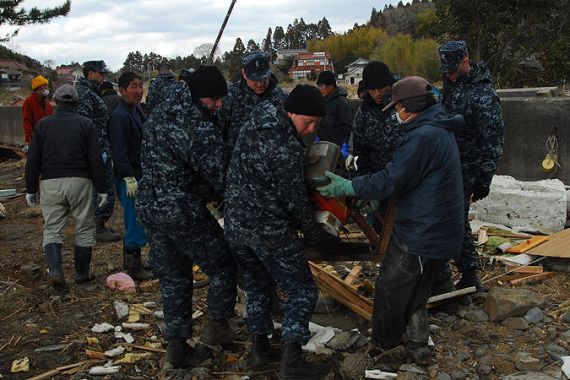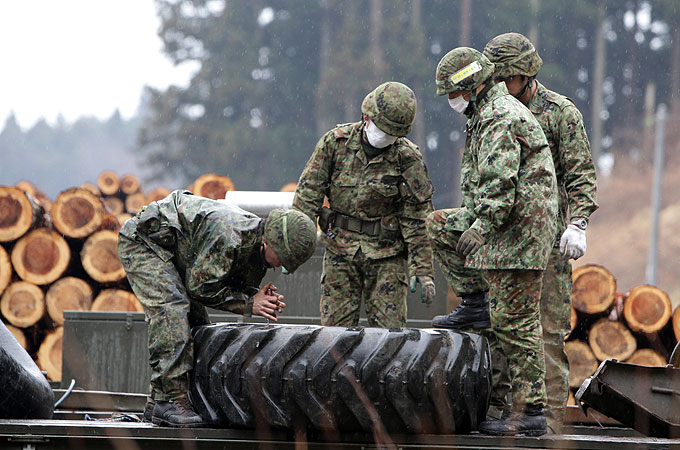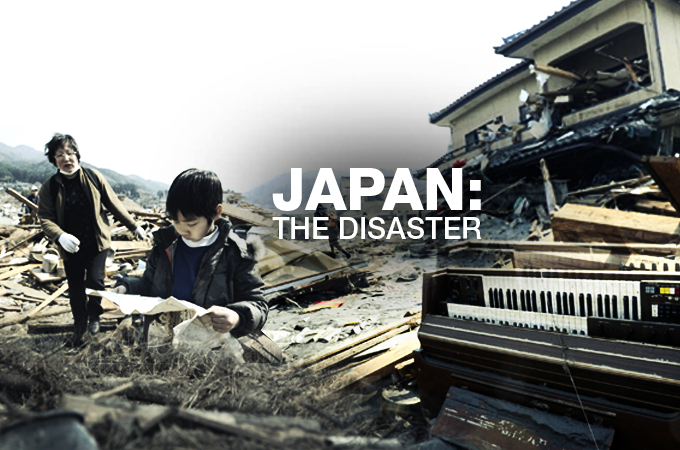Fresh search for Japan tsunami dead
Japanese and US troops launch massive hunt for bodies as thousands remain missing a month after quake-triggered tsunami.

 |
| A month after the earthquake and tsunami, many people are still missing [EPA] |
The Japanese and the US troops have launched another all-out search for the bodies of earthquake and tsunami victims along the country’s ravaged northeast coast.
About 22,000 Japanese troops, along with 110 from the US, searched by land, air and sea on Sunday.
Keep reading
list of 4 itemsTurtles swimming to extinction in Malaysia as male hatchlings feel heat
Could shipping containers be the answer to Ghana’s housing crisis?
Thousands protest against over-tourism in Spain’s Canary Islands
Television news footage showed them using heavy equipment to lift a boat washed inland by the tsunami so they could search a crushed car underneath. No one was inside the car.
The troops also used shovels to dig through mud.
The latest search was to last just one day and did not include the evacuation zone around the tsunami-flooded nuclear complex that is spewing radiation.
Troops and police officers, decked out in full protective gear, continued the dangerous, painstaking work of searching the area closest to the quake-affected Fukushima Dai-ichi plant.
 |
| To follow all of Al Jazeera’s special coverage, click here |
“A month after the earthquake and tsunami, many people are still missing,” Norikazu Muratani, Japanese defence ministry spokesman, said.
“We would like to do our utmost to find bodies for their families.”
Nearly 13,000 people are known to have died in the disaster, with another 15,000 still officially listed as missing. Many bodies have likely washed out to sea and may never be found.
A similar three-day search with even more troops a week ago found just 70 bodies, underscoring the difficulties of locating victims in the debris along the coast washed away by the tsunami.
Meanwhile, Naoto Kan, the Japanese prime minister, visited Ishinomaki, a coastal city of 163,000 people in Miyagi, one of the hardest-hit prefectures.
In his second visit to disaster zones, Kan pledged he would “never abandon” survivors of tsunami as he tried to focus attention on the future, despite a high-stakes battle at the Fukushima plant.
“The government will do its utmost to help you,” he told government officials.
More than 2,600 residents were killed in the disaster and another 2,800 are missing in Ishinomaki. Boats were also destroyed, crippling the fishing industry that accounts for 40 per cent of the town’s economy.
Radiation battle at Fukushima
Japanese engineers hope to stop pumping radioactive water into the sea on Sunday and start moving more highly contaminated water out of a crippled nuclear reactor – a key step in gaining access and restoring the critical cooling system.
An unmanned drone is scheduled to fly over four reactors at the plant to video the extent of damage in areas where workers are unable to safely enter due to high radiation.
Japan is struggling to contain the worst atomic crisis since Chernobyl after the massive earthquake and tsunami devastated its northeast last month.
“There are still numerous aftershocks and there is no room for complacency regarding the situation (at Fukushima Dai-ichi),” Tetsuro Fukuyama, Japan’s Deputy Cabinet Secretary, said.
Efforts to regain control of six reactors hit by the tsunami have been hindered by radiation fears.
Workers have poured in seawater to cool fuel rods, but in the process have left the plant flooded with radioactive water which they have pumped back into the sea to make room for much more contaminated water.
Significantly, contamination levels in the sea near the plant have actually fallen over the past few days after workers managed to stop a leak of highly radioactive water that was pouring directly into the ocean.
Work at the plant has been slow because radiation levels are so high in some areas that workers can enter only for short periods of time, or not at all.
Residents who live within 20km of the plant have been evacuated over radiation concerns.
Food safety
The contamination has raised concerns about food safety, and the government announced on Friday that it was setting a new radiation standard for rice and would prohibit farmers from planting in soil with levels of radioactive caesium that are too high.
Many neighbouring countries have expressed alarm over possible contamination drifting in their direction.
Japanese food’s worldwide reputation for quality and safety took another hit with a report on Sunday that a high level of caesium had been found in the sand lance, or konago fish.
Radiation has already been found in tap water and in farm produce from the region, leading to bans at home and abroad.